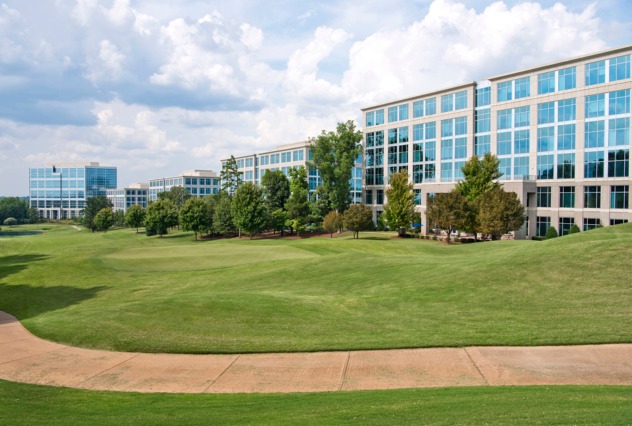
Returning to the Office
Ballantyne companies discuss workforce plans
By Andrea Cooper
See if any of these scenarios sound familiar from the homebound workplace of 2020-‘21: Your cat lands on your desk, filling your Zoom presentation with her furry presence. You hear something crash during your virtual training session just before your 8-year-old yells, “Dad!” You’re conducting a virtual job interview when your spouse strolls past, visible onscreen, chowing down on a sandwich.
No wonder some workers are desperate to return to the office. Other employees are clamoring to stay safely home, where they feel they can be productive without worrying about colleagues’ vaccination statuses.
Ballantyne workplaces are returning to normal. Yet, few employers are certain what “normal” will look like. The 535-acre Ballantyne campus is home to 30-plus Fortune 500 companies and more than 300 businesses. Before the pandemic, 17,000 people worked in Ballantyne daily.

In the Ballantyne office of national homebuilder Taylor Morrison, discussions are underway about a full return to the office. “Candidly, we don’t have a plan yet set,” says Andrew Bodary, vice president of finance for the company’s Charlotte division. “We’ve had a pretty healthy, emotional discussion, as people have varying views of what the next steps look like and what the work environment will look like.” About half of the company’s Ballantyne employees are currently allowed in the office at any given time.
Employers are facing issues that would have been unthinkable in 2019, from workplace rules about social distancing and wearing masks in common areas to whether COVID-19 vaccinations should be required. (Such a requirement is legal, according to the U.S. Equal Employment Opportunity Commission. Advisable? That’s a different question.)
Fifty-two percent of U.S. workers prefer a hybrid model that combines in-office and remote work, according to a summer/fall 2020 survey by Gensler, a global architecture, design and planning firm. The survey, which collected responses from 2,300 U.S. workers, found senior leaders were the keenest to work partly from home.
“The future of work is hybrid,” says Carrie Renegar, senior associate design director with Gensler in Charlotte. “We’ve all proven that we can work from home, but we also need the office as a place for collaborating with our teams and socializing with our colleagues.”
It’s unclear when many Ballantyne workers will be in the office in full force. Brighthouse Financial, Inc., which employs about 800 in its Ballantyne headquarters, is among those waiting until fall 2021 or later. “Our current plans include a phased re-entry that will gradually increase the number of employees on-site over time,” says Kristina Stankoski, real estate director at the Fortune 500 company, which sells life insurance and annuities. According to an internal survey, social distancing in workspaces and enhanced cleaning procedures rank high among what employees want when they return.


